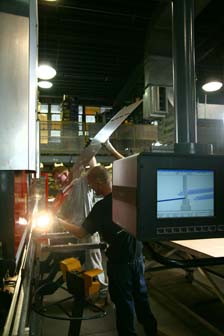Summary
Please enable javascript to play this video.
| Quick Facts: Sheet Metal Workers | |
|---|---|
|
$60,850 per year
$29.26 per hour |
|
| High school diploma or equivalent | |
| None | |
| Apprenticeship | |
| 127,000 | |
| 2% (Slower than average) | |
| 3,100 | |
What Sheet Metal Workers Do
Sheet metal workers fabricate or install products that are made from thin metal sheets.
Work Environment
Sheet metal workers often lift heavy materials and stand for long periods of time. Those who install sheet metal must often bend, climb, and squat. Most work full time.
How to Become a Sheet Metal Worker
Sheet metal workers employed in construction typically learn their trade through an apprenticeship. Those employed in manufacturing typically learn on the job or at a technical school.
Pay
The median annual wage for sheet metal workers was $60,850 in May 2024.
Job Outlook
Employment of sheet metal workers is projected to grow 2 percent from 2024 to 2034, slower than the average for all occupations.
Despite limited employment growth, about 10,600 openings for sheet metal workers are projected each year, on average, over the decade. Most of those openings are expected to result from the need to replace workers who transfer to different occupations or exit the labor force, such as to retire.
State & Area Data
Explore resources for employment and wages by state and area for sheet metal workers.
Similar Occupations
Compare the job duties, education, job growth, and pay of sheet metal workers with similar occupations.
More Information, Including Links to O*NET
Learn more about sheet metal workers by visiting additional resources, including O*NET, a source on key characteristics of workers and occupations.
 United States Department of Labor
United States Department of Labor












